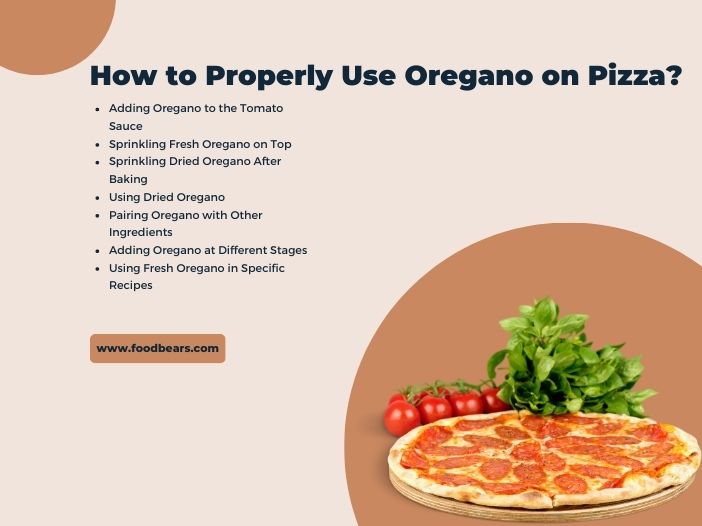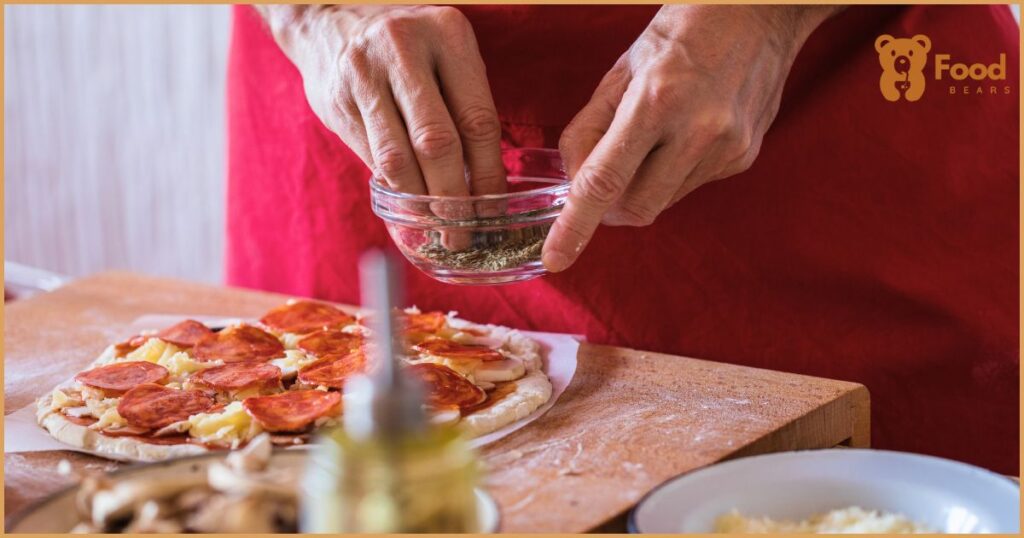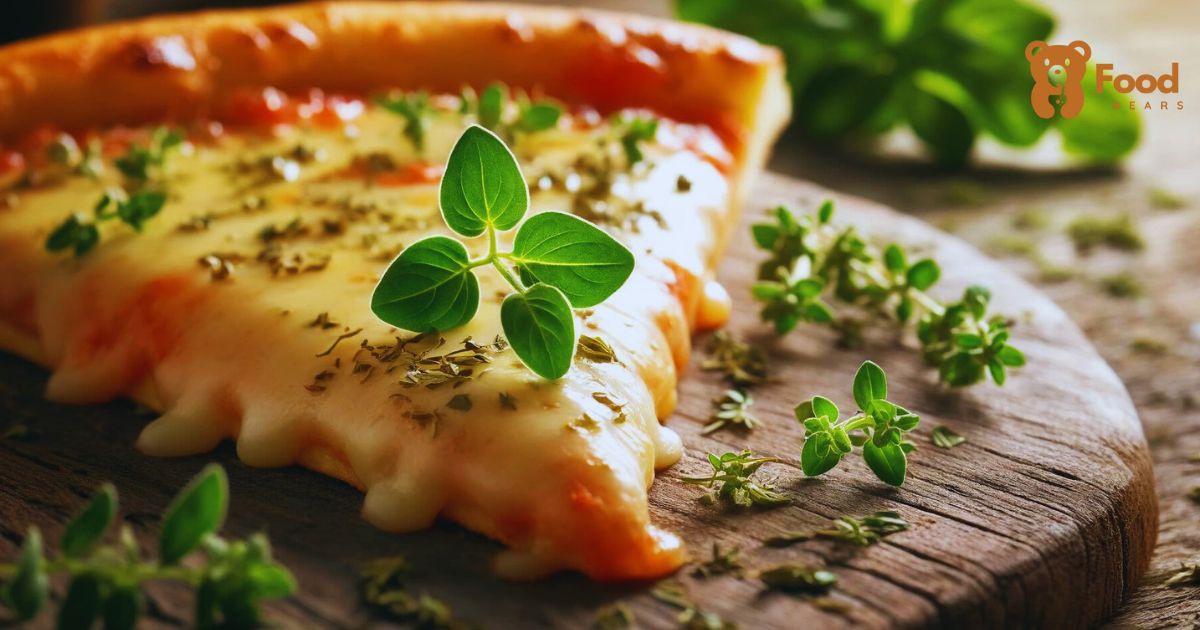Yes, Oregano goes on pizza. It's a game-changer for the flavor of pizza. It brings a certain depth and complexity that enhances other ingredients.
Whether you use it as a topping or infused in the sauce, oregano is undeniably a surprising element in creating the perfect pizza experience. Oregano, that unassuming green sprinkle on your pizza, packs a punch you can’t ignore.
It’s a minor ingredient with a big job. Today, we will explore its role, impact, and irreplaceable contribution to our favorite cheesy delight. We’ll tackle questions like why Oregano works so well on pizza.
Or how does it enhance the taste of other ingredients? Stick around as we undertake this flavorful journey into the world of oregano and pizza.
What is Oregano?

Oregano, scientifically known as Origanum vulgare, is a hearty perennial herb from the mint or Lamiaceae family. It’s a plant that, when in full bloom, gives pink or purple flowers, which are also edible.
This herb, a member of the mint family, is renowned for its robust, slightly bitter, and somewhat peppery flavor.
The Greek language celebrates this plant with the name “joy of the mountain.” Its peppery bite and minty aroma have made it a joy for chefs and food lovers, especially in Mediterranean cuisine. Plus, it’s gluten-free. That makes it suitable for vegan and paleo diets.
So, when you sprinkle Oregano on your pizza, you’re participating in a culinary tradition that spans centuries and continents.
Oregano is esteemed in pizza toppings, especially in the United States. It’s a natural companion to the classic ingredients found on a pizza, forming a harmonious blend of cheese, tomato, and various meats.
Why Do You Put Oregano on Pizza?

We commonly sprinkle oregano over pizza to enhance its taste and flavor. This culinary spice, widely used as a preservative, is packed with numerous nutrients like vitamins, minerals, fiber, and omega-3 fatty acids.
It also contributes to the taste of foods and beverages and offers several health benefits.
1. Flavor Enhancement
Oregano is a staple in Italian cuisine, and pizza is no exception. The herb has a robust, warm flavor with a hint of sweetness and earthiness that complements the tangy tomato sauce and rich cheese on pizzas.
Adding oregano to your pizza elevates the taste. It also adds a layer of complexity to the flavor. It’s like the secret ingredient that makes the pizza taste authentically Italian.
2. Nutrient Rich
Oregano is a powerhouse of nutrients. Just one teaspoon of dried oregano can provide you with small amounts of vitamins K, E, and A, as well as calcium, potassium, and iron.
So, when you’re enjoying your pizza, you also give your body some beneficial nutrients. It’s a delicious way to nourish your body.
| Nutrient | Benefit |
|---|---|
| Vitamin K | Important for blood clotting and bone health |
| Vitamin E | Acts as an antioxidant, protecting cells from damage |
| Vitamin A | Supports eye health and the immune system |
| Calcium | Essential for bone health and muscle function |
| Potassium | Helps regulate fluid balance, nerve signals, and muscle contractions |
| Iron | Vital for making red blood cells and transporting oxygen in the body |
3. Versatility
Oregano’s versatility is one of the reasons it’s so popular in cooking. Its robust flavor pairs well with various ingredients commonly found on pizzas, such as:
- Tomatoes
- Olives
- Bell peppers
- Onions
- Various types of cheese
This means it can enhance the taste of almost any pizza, whether it’s a simple Margherita or a loaded veggie pizza.
4. Blood Sugar Regulation
Some research suggests that oregano helps to regulate blood sugar levels. It contains polyphenols and flavonoids, which help to lower blood sugar.
This is particularly beneficial for people who are watching their blood sugar levels. So, while savoring your pizza, you are also helping your body maintain a healthy balance.
Here’s a table that explains how oregano can potentially help with blood sugar regulation:
| Compound | Benefit |
|---|---|
| Polyphenols | These are antioxidants that have been found to help lower blood sugar levels. |
| Flavonoids | These compounds have anti-inflammatory and antioxidant effects, which can help manage blood sugar levels. |
5. Antibacterial Properties
Oregano has antibacterial properties. It contains compounds like thymol and carvacrol, which inhibit the growth of bacteria like E. coli and Bacillus subtilis.
While the amount of oregano on your pizza might not be enough to have a significant effect, it’s still a nice bonus!
6. Antioxidant Powerhouse
Oregano is rich in antioxidant substances that help protect your cells against damage by harmful molecules called free radicals.
Gram for gram, oregano has one of the highest antioxidant activity ratings of any food. Adding oregano to your pizza could help your body fight off oxidative stress.
Here’s a table that highlights the antioxidant properties of oregano:
| Antioxidant | Benefit |
|---|---|
| Thymol | A phenolic compound that neutralizes harmful free radicals, helping to prevent cell damage and inflammation. |
| Carvacrol | This compound has strong antioxidant properties that can help protect against cellular damage. |
| Rosmarinic Acid | This antioxidant helps protect the body’s cells from damage by free radicals. |
| Vitamin E | A powerful antioxidant that helps protect your cells from damage. |
These antioxidants work together to help protect your body from oxidative stress, which can lead to chronic diseases like heart disease and cancer.
So, when you add oregano to your pizza, you’re not just enhancing the flavor. You’re also boosting its antioxidant power.
7. Skin Health
While it might seem strange to connect pizza with skin health, oregano does have potential benefits for the skin. It’s rich in antioxidants and vitamins that can nourish your skin.
Some people use oregano oil topically to help with skin conditions like acne and rosacea. While eating pizza probably won’t have the same effect, it’s another testament to the versatility of oregano.
8. Versatile Herb
Oregano is a highly versatile herb used in various dishes, not just pizza. Its robust, earthy flavor pairs well with various ingredients.
It makes it a staple in many cuisines. In Italian cooking, oregano is used in everything from pasta sauces to roasted vegetables and grilled meats.
It’s also a key ingredient in Greek cuisine, often used in meat, fish marinades, hearty stews, and salads. The versatility of oregano also extends to its form. You can use it fresh or dried; both forms have unique benefits.
Fresh oregano has a milder and sweeter flavor, while dried oregano has a more robust, more concentrated flavor. That means you can adjust the type of oregano you use based on the flavor intensity you’re aiming for.
Here’s a table that highlights the versatility of oregano:
| Use | Description |
|---|---|
| Italian Cuisine | Oregano is a staple in Italian cooking, used in pasta sauces, pizzas, and roasted vegetables. |
| Greek Cuisine | In Greek cuisine, oregano is often used in marinades for meat and fish and in salads and stews. |
| Fresh or Dried | Oregano can be used in both fresh and dried forms. Fresh oregano has a milder flavor, while dried oregano has a more concentrated, robust flavor. |
| Variety of Dishes | Beyond Italian and Greek cuisines, oregano can be used in various dishes, from soups and stews to grilled meats and roasted vegetables. |
This table shows just how versatile oregano is. It’s a herb that can enhance a wide range of dishes, making it a valuable addition to any kitchen.
9. Healthy Herb
Oregano is not just a flavor enhancer. It’s also a healthy addition to your meals. As discussed earlier, it’s rich in vitamins and minerals, such as vitamin K, iron, and calcium.
But that’s not all. Oregano also has a high antioxidant content, which helps to protect your body from harmful free radicals. Antioxidants are crucial in maintaining your health by preventing cell damage that can lead to chronic diseases.
Here’s a table that breaks down the health benefits of oregano based on its nutritional content:
| Nutrient | Amount per 100g | Benefit |
|---|---|---|
| Total Calories | 265 | Provides energy for your body |
| Total Fat | 4.3g | Necessary for normal body function |
| Sodium | 25mg | Helps control blood pressure and volume |
| Total Carbohydrates | 69g | The main source of energy for your body |
| Dietary Fiber | 43g | Aids in digestion and helps you feel full |
| Sugar | 4.1g | A quick source of energy |
| Protein | 9g | Essential for building and repairing tissues |
| Vitamin A | 34% of Daily Value | Supports eye health and the immune system |
| Vitamin C | 3.7mg | Supports immune health and skin health |
| Calcium | 1.6g | Essential for bone health and muscle function |
| Iron | 37mg | Vital for making red blood cells and transporting oxygen in the body |
These values are based on a 2000-calorie diet. Please note that the actual amounts can vary based on the specific type and brand of oregano and the serving size. Always check the nutritional information on the packaging for the most accurate information.
10. Affordability
Oregano is an affordable way to add flavor to your pizza. You can find it easily in grocery stores and online; a little goes a long way. This means you can enjoy the benefits of oregano without putting a dent in your wallet.
How to Properly Use Oregano on Pizza?

You can elevate the flavors of your homemade pies to a whole new level by learning how to use oregano on pizza properly.
Fresh Oregano is generally recommended for toppings, and dried oregano is perfect for seasoning the sauce and crust. You can always experiment with fresh and dried and find out which one you prefer.
Let’s explore this in more detail:
1. Adding Oregano to the Tomato Sauce
This is a great way to infuse your pizza with the flavor of oregano from the very beginning. Whether you’re using fresh or dried oregano, you can add it directly to your tomato sauce. This will give your sauce an earthy note that permeates the entire pizza.
Just remember, if you're using fresh oregano, chop it finely before adding it to the sauce.
2. Sprinkling Fresh Oregano on Top
This method is for you if you’re a fan of fresh herbs. Slice fresh oregano leaves and sprinkle them over the top of your pizza. This will give your pizza a burst of fresh, herbal flavor. It’s also a great way to add color and texture to your pizza.
3. Sprinkling Dried Oregano After Baking
This method is all about timing. By sprinkling dried Oregano on your pizza immediately after it comes out of the oven, the heat from the pizza releases the flavors of the Oregano. This will give your pizza a robust, aromatic flavor that will impress everyone.
4. Using Dried Oregano
While fresh oregano has its place, dried oregano is also preferred for pizza. Dried oregano has a more concentrated flavor, which means it can stand up to the other intense flavors on a pizza. Plus, it’s easy to sprinkle on and requires no prep work.
5. Pairing Oregano with Other Ingredients
Oregano is a versatile herb that complements a variety of ingredients. It pairs well with tomato sauce and savory ingredients like cheese, olives, and mushrooms. Don’t be afraid to experiment with different combinations to find your favorite.
6. Adding Oregano at Different Stages
You can add oregano to your pizza at different stages of the cooking process to achieve other effects. For example, adding it to the sauce before baking will infuse the entire pizza with its flavor.
Sprinkling it on before baking will give it a more baked-in flavor. And adding it after baking will provide a fresh, aromatic note. Try finishing with a sprinkle of parmesan and a drizzle of olive oil for an extra flavor.
7. Using Fresh Oregano in Specific Recipes
Fresh oregano can be a star ingredient in specific pizza recipes. For example, a Fresh Tomato Pizza with Oregano and Mozzarella would showcase the herb’s unique flavor. In this case, you’d likely use the Oregano in the sauce and as a topping to let it shine.
How Do You Put Oregano on Pizza: Before Baking or After Baking?

Oregano is a versatile herb that can enhance pizza flavor in different ways. Whether you add it before or after baking, oregano can complement the taste of tomato sauce and traditional pizza.
It is recommended to use dried oregano on pizza as it brings out the most flavor profile for your pizza while keeping it simple.
You can use oregano on your pizza, either before or after baking.
Before Baking:
- Adding Oregano to the Tomato Sauce: This is a fantastic way to infuse your pizza with the flavor of oregano right from the start. You will layer the flavors when you add oregano to your tomato sauce. The oregano mixes with the tomato, garlic, and other ingredients in the sauce, enhancing the overall flavor profile of the pizza. It’s similar to adding a base coat before nail polish – it protects your nails and helps the color stand out.
- Incorporating Oregano into the Dough: This method is unconventional but can yield delicious results. You’re embedding the flavor directly into the pizza crust by kneading oregano into your bread dough. As the pizza bakes, the heat will release the aroma of the oregano, creating a savory, fragrant crust. It’s like hiding a surprise inside a gift – the recipient doesn’t know what’s inside until they open it.
- Adding Oregano to the Toppings Before Baking maximizes your toppings’ flavor. By sprinkling oregano over your toppings before baking, the oven’s heat draws out the essential oils in the oregano. It will enhance the flavor of the cheese and other toppings. It’s like marinating meat before grilling – the spices penetrate the meat, making it more flavorful.
After Baking:
- Sprinkling Dried Oregano After Baking: This method captures the essence of oregano at its most potent. When you sprinkle dried oregano on your pizza immediately after baking, the residual heat from the pizza warms the oregano. This releases its aroma and flavor. It’s like applying perfume to your pulse points – your body’s warmth helps diffuse the scent.
- Adding Oregano to the Toppings After Baking enhances your pizza’s taste and visual appeal. Whether you use fresh or dried oregano, adding it to your pizza toppings after baking gives an extra layer of flavor. It also adds a pop of color and texture. It’s like garnishing a dish before serving – it adds visual interest and enhances the overall dining experience.
- Using Oregano as a Topping After Baking: This method adds a final touch of flavor. Sprinkling oregano over your pizza after baking adds a fresh, herbal flavor that complements the other ingredients. It’s like adding a cherry to your sundae – the finishing touch completes the dish.
Oregano on Top vs. In the Sauce
Whether you’re a fan of oregano in the sauce or sprinkled on top, there’s no wrong way to enjoy this versatile herb on your pizza.
Oregano in the Sauce
When you add oregano to your pizza sauce, you’re infusing the entire pizza with the herb’s flavor. As the sauce cooks on the stove or in the oven, it helps release the oregano’s essential oils, spreading its earthy, slightly bitter flavor throughout the pizza. This method is excellent if you want a consistent oregano flavor in every bite of your pizza.
Oregano on Top
On the other hand, sprinkling oregano on the pizza before or after baking gives a different experience. If you add it before baking, the oven’s heat will toast the oregano, slightly change its flavor, and give it a bit of a crunch.
Adding the oregano after baking will retain more of its fresh, herbal flavor and aroma. This method is excellent if you want a burst of oregano flavor and a bit of texture with each bite.
Which Pizza Has Oregano?
Many types of pizza use oregano for its soothing aroma and flavor. Here are some types of pizza that typically have oregano.
- Margherita Pizza: This is a simple yet flavorful pizza where oregano often plays a starring role. It complements the fresh mozzarella and tomatoes, adding a depth of flavor that makes this classic pizza a perennial favorite.
- Pepperoni Pizza: Oregano is a common addition to this popular pizza. It adds an earthy note that pairs well with the spicy pepperoni and rich cheese.
- Vegetarian Pizza: Oregano is also used on many vegetarian pizzas. It enhances the flavors of the various vegetables without overpowering them.
- Greek Pizza: Given oregano’s prominence in Greek cuisine, it’s no surprise that it’s often featured on Greek-style pizzas. It complements ingredients like feta, olives, and tomatoes.
- Tomato Sauce Pizza: This pizza truly lets the sauce shine, and oregano is a key player. It adds an earthy, slightly bitter note that complements the sweet acidity of the tomatoes.
- Neapolitan Pizza: As a traditional Italian pizza, Neapolitan often features oregano. It’s a simple pizza with few ingredients. So the oregano stands out, enhancing the fresh tomatoes and mozzarella flavors.
- Garlic and Oil Pizza: This pizza, also known as Pizza Bianca, often uses oregano to add a bit of complexity to the simple combination of garlic and oil. The oregano adds a depth of flavor that takes the pizza to the next level.
What Are Some Other Herbs That Go Well with Oregano On Pizza?
Many herbs and spices are used on pizza to enhance the flavor. Here they are:
- Basil: Basil is like the best friend of oregano on a pizza. They’re both part of the mint family and share a similar flavor profile. You can use fresh basil leaves in almost every pizza recipe, adding a sweet, peppery flavor. It’s like adding a splash of color to a painting – it brightens everything up.
- Thyme: Thyme is a bit like the secret ingredient in your pizza. It has a slightly sweet and earthy flavor that can enhance the overall taste of your pizza. Adding a pinch of salt to your dough subtly enhances the other flavors.
- Rosemary: Rosemary is the bold character in your pizza’s story. It has a robust and pine-like aroma and a slightly bitter taste. Use it sparingly on your pizza, like you would use a strong perfume – a little goes a long way.
- Garlic: Garlic is like the kick in your favorite dance song. It has an intense and spicy flavor that can add a whole new dimension to your pizza. You can use both garlic and garlic powder on your pizza. It’s like adding a plot twist to a story – it makes everything more exciting.
- Black Pepper: Black pepper is the spice of life on your pizza. It has a sharp and spicy taste that can add a little heat to your pizza. It’s like adding a dash of adventure to a relaxing vacation – it spices things up.
- Crushed Red Pepper: Crushed red pepper is the firecracker on your pizza. It has a spicy and smoky flavor that can add a kick to your pizza. It’s like adding a thrilling scene to a movie – it gets your heart racing.
- Parsley: Parsley is like the finishing touch on your pizza. It has a fresh and slightly bitter taste that can add color and flavor to your pizza. It’s like adding a bow to a gift – it completes the package.
FAQs
Q. Does Oregano belong in pasta sauce or just pizza sauce?
Oregano can be a fantastic addition to pasta sauce! It’s not just for pizza. Oregano adds an earthy, slightly bitter flavor that can enhance the taste of a tomato-based pasta sauce. It’s like adding a bit of jazz to a classic song – it gives it a new twist while keeping the original charm.
Q. Why is oregano seasoning powder given along with pizza?
Oregano seasoning powder is often given with pizza because it’s a quick and easy way to add an extra flavor. Sprinkling it on a hot pizza can bring out the aroma and taste of the oregano.
Q. Does Margherita Pizza have Oregano?
Yes, a classic Margherita pizza often features oregano. The earthy oregano flavor beautifully complements the simple combination of fresh tomatoes, mozzarella, and basil.
Q. Do Italians use Oregano on pizza?
Yes, Italians do use oregano on pizza, especially in southern Italy. However, like many culinary traditions, it can vary by region. Some might prefer fresh basil, while others love the robust flavor of oregano.
Wrap Up the Oregano-Pizza Dilemma
So, what’s the final verdict on oregano after all our pizza talk? Well, it’s a big thumbs up for sure. Oregano, especially the Greek variety, can amp up your pizza game. Whether you prefer it fresh or dried, it’s all good.
Remember, a little goes a long way. Oregano is a powerful player, but it knows how to work well with others, enhancing rather than overpowering. You can mix it into your sauce or even your dough for that authentic Italian flavor.
So, don’t forget that oregano next time you make a pizza. It’s an easy way to level up your pizza night.

Ella Foster, co-founder of FoodBears.com, is a skilled writer whose love for cooking fuels her creative work. Her passion for experimenting in the kitchen brings authentic flavor and culinary inspiration to every piece she crafts for the platform.
